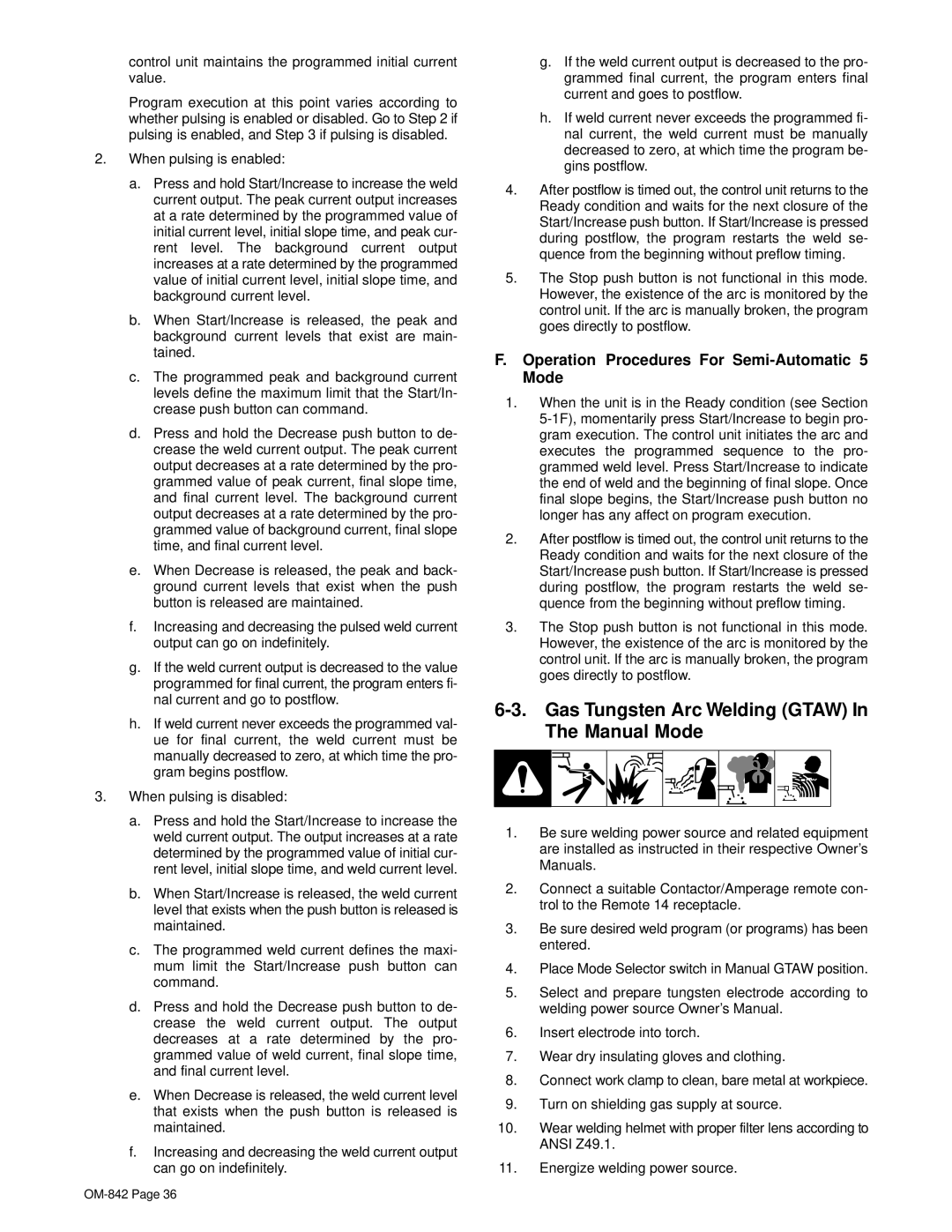control unit maintains the programmed initial current value.
Program execution at this point varies according to whether pulsing is enabled or disabled. Go to Step 2 if pulsing is enabled, and Step 3 if pulsing is disabled.
2.When pulsing is enabled:
a.Press and hold Start/Increase to increase the weld current output. The peak current output increases at a rate determined by the programmed value of initial current level, initial slope time, and peak cur- rent level. The background current output increases at a rate determined by the programmed value of initial current level, initial slope time, and background current level.
b.When Start/Increase is released, the peak and background current levels that exist are main- tained.
c.The programmed peak and background current levels define the maximum limit that the Start/In- crease push button can command.
d.Press and hold the Decrease push button to de- crease the weld current output. The peak current output decreases at a rate determined by the pro- grammed value of peak current, final slope time, and final current level. The background current output decreases at a rate determined by the pro- grammed value of background current, final slope time, and final current level.
e.When Decrease is released, the peak and back- ground current levels that exist when the push button is released are maintained.
f.Increasing and decreasing the pulsed weld current output can go on indefinitely.
g.If the weld current output is decreased to the value programmed for final current, the program enters fi- nal current and go to postflow.
h.If weld current never exceeds the programmed val- ue for final current, the weld current must be manually decreased to zero, at which time the pro- gram begins postflow.
3.When pulsing is disabled:
a.Press and hold the Start/Increase to increase the weld current output. The output increases at a rate determined by the programmed value of initial cur- rent level, initial slope time, and weld current level.
b.When Start/Increase is released, the weld current level that exists when the push button is released is maintained.
c.The programmed weld current defines the maxi- mum limit the Start/Increase push button can command.
d.Press and hold the Decrease push button to de- crease the weld current output. The output decreases at a rate determined by the pro- grammed value of weld current, final slope time, and final current level.
e.When Decrease is released, the weld current level that exists when the push button is released is maintained.
f.Increasing and decreasing the weld current output can go on indefinitely.
g.If the weld current output is decreased to the pro- grammed final current, the program enters final current and goes to postflow.
h.If weld current never exceeds the programmed fi- nal current, the weld current must be manually decreased to zero, at which time the program be- gins postflow.
4.After postflow is timed out, the control unit returns to the Ready condition and waits for the next closure of the Start/Increase push button. If Start/Increase is pressed during postflow, the program restarts the weld se- quence from the beginning without preflow timing.
5.The Stop push button is not functional in this mode. However, the existence of the arc is monitored by the control unit. If the arc is manually broken, the program goes directly to postflow.
F.Operation Procedures For Semi-Automatic 5 Mode
1.When the unit is in the Ready condition (see Section 5-1F), momentarily press Start/Increase to begin pro- gram execution. The control unit initiates the arc and executes the programmed sequence to the pro- grammed weld level. Press Start/Increase to indicate the end of weld and the beginning of final slope. Once final slope begins, the Start/Increase push button no longer has any affect on program execution.
2.After postflow is timed out, the control unit returns to the Ready condition and waits for the next closure of the Start/Increase push button. If Start/Increase is pressed during postflow, the program restarts the weld se- quence from the beginning without preflow timing.
3.The Stop push button is not functional in this mode. However, the existence of the arc is monitored by the control unit. If the arc is manually broken, the program goes directly to postflow.
6-3. Gas Tungsten Arc Welding (GTAW) In The Manual Mode
1.Be sure welding power source and related equipment are installed as instructed in their respective Owner’s Manuals.
2.Connect a suitable Contactor/Amperage remote con- trol to the Remote 14 receptacle.
3.Be sure desired weld program (or programs) has been entered.
4.Place Mode Selector switch in Manual GTAW position.
5.Select and prepare tungsten electrode according to welding power source Owner’s Manual.
6.Insert electrode into torch.
7.Wear dry insulating gloves and clothing.
8.Connect work clamp to clean, bare metal at workpiece.
9.Turn on shielding gas supply at source.
10.Wear welding helmet with proper filter lens according to ANSI Z49.1.
11.Energize welding power source.

